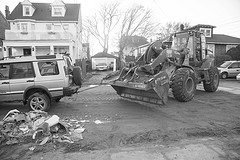When disasters strike, our first responders ensure that emergency resources get to those in need. But when the immediate danger has passed, communities need a different kind of support. For families, recovery depends on repairing damage that has rendered homes uncomfortable, unsafe or even unlivable, whether that means repairing flooded drywall or electrical damage or undertaking longer term, larger scale rebuilding projects. Now some unlikely players – community development financial institutions (CDFIs) – are showing how they can be critical during the recovery phase.
As the largest investor in CDFIs, we at Bank of America know the positive impact these community development institutions have on communities. What we didn’t anticipate is the pivotal role they could play in disaster recovery. We’re seeing this in New York and New Jersey after Hurricane Sandy where the flexibility and speed of CDFIs matched with their deep knowledge of communities is filling a gap between the initial relief and longer term rebuilding efforts.
For homeowners that urgently needed the cash to rebuild before the onset of winter weather or more serious damage, CDFIs were there. They adapted their standard renovation loan product to factor in expected insurance settlements and potential FEMA payouts as well as income. This filled a need by providing bridge funding as many families waited for insurance payoffs.
There were some positive developments with Sandy that could serve as a model. Not wanting to waste time and resources creating an agency for the purposes of issuing small loans to homeowners in need, New York’s Mayor Bloomberg instead turned to a CDFI. This saved time and money and, most importantly, got the cash to those in need. Other cities should consider leveraging this existing network in future recovery efforts.
The private sector – including Bank of America – also stepped in to invest in CDFIs operating in New York and New Jersey. In addition to philanthropic donations in the immediate aftermath of the storm, we invested $20 million at zero-percent interest and deferred principal repayment.
If you think about the stages after a disaster, the first is relief – taking care of immediate needs, making sure that people have emergency food, water and shelter. Generosity and donations can make a difference in this stage. The longer term stage is rebuilding and it’s bigger than any philanthropic support; this involves billions of dollars and large-scale financing. In between is the recovery phase, where people need more than emergency relief and more than donations, but the structure for long term rebuilding is not yet in place. This is the sweet spot for CDFIs who provide fast and flexible financing.
As we focus on getting storm-damaged communities back in working order, let’s not forget the role of CDFIs.
(Photo from the Far Rockaways, Queens by Kate Gardiner, CC BY-NC.)





As a CDFi who has responded to disasters, I want to thank Dan for his post and for Bank of America’s commitment to recovery. CDFIs have been and can be major players in helping residents, homeowners and small businesses in rebuilding and returning to normal. Government and bank support are key to these efforts.
Roberto Barragan
VEDC, California